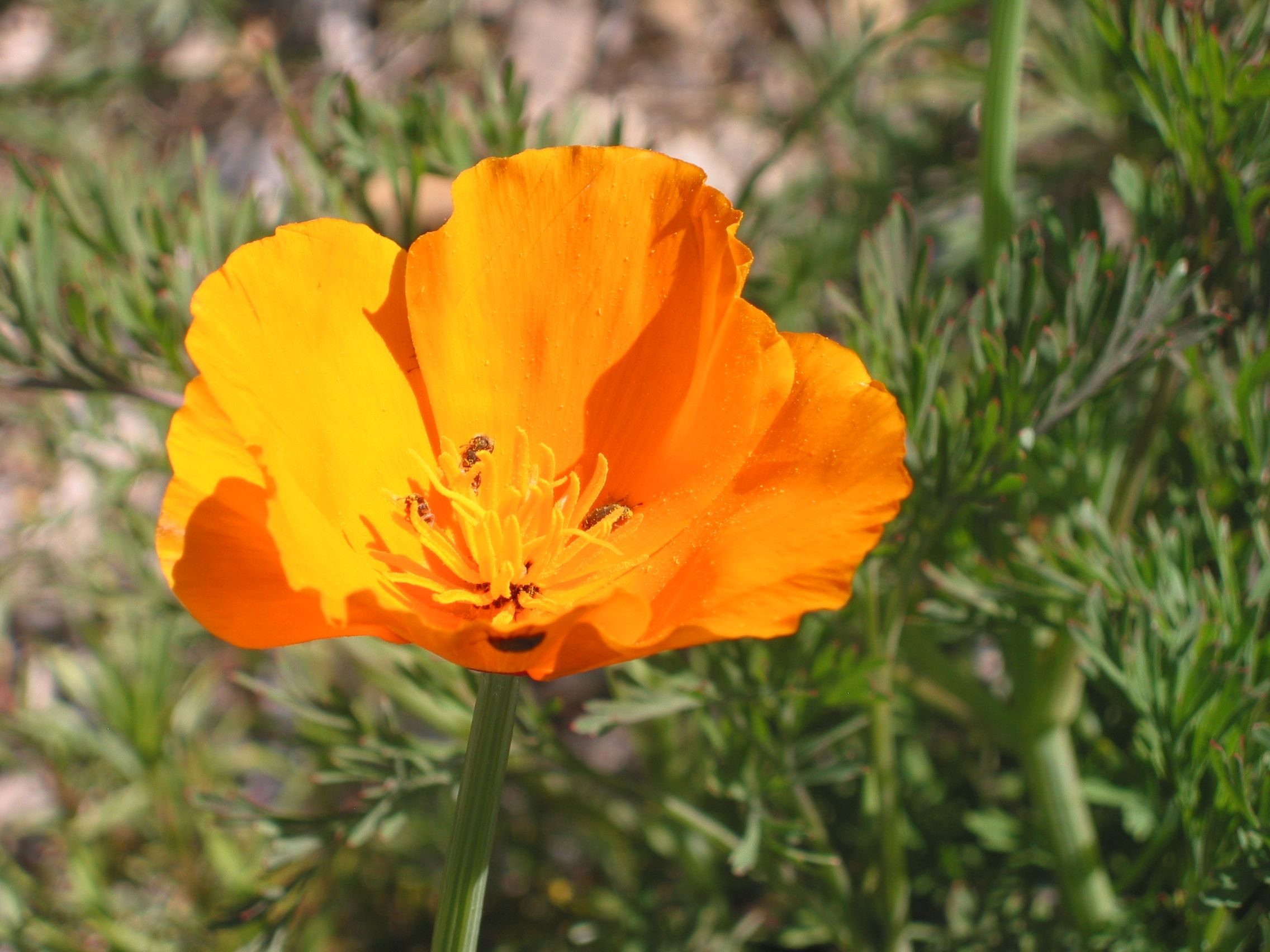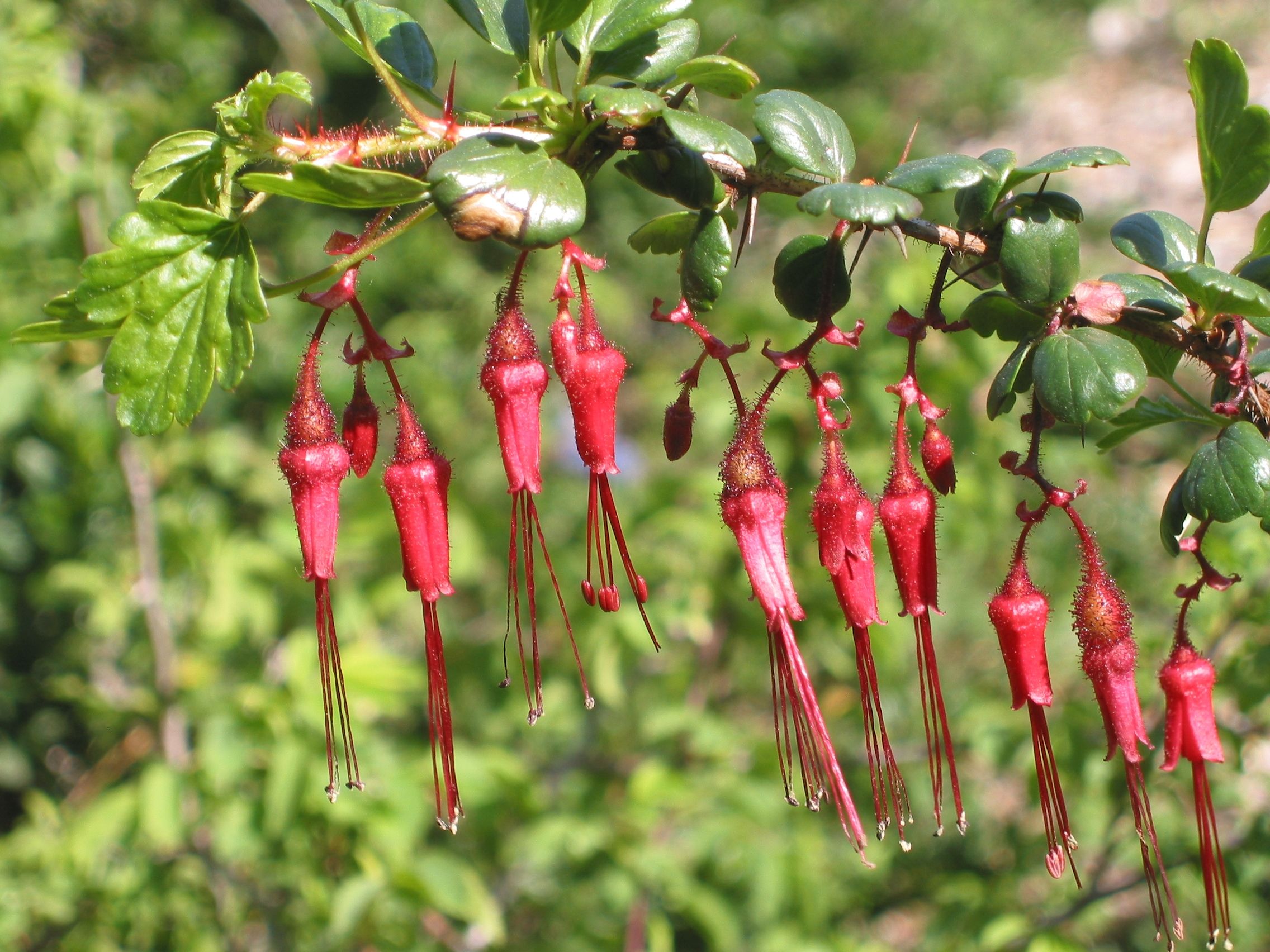What does native mean?
From the Davis Enterprise, March 26, 2009
First a rave, then a rant.
I strongly suggest you go take a walk in the Arboretum soon. In particular, the Mary Wattis Brown Garden of California Native Plants is lovely. California poppy, Island bush poppy, Wild lilac, Fuchsia-flowered gooseberry, currants, and redbuds are all in bloom. A shaggy meadow of native grasses hints at possible alternatives to the traditional lawn. You'll see more currants and redbuds as you walk to the west, passing under the shade of old Valley oaks. Heucheras are flowering, and bright green new growth is pushing on the Catalina ironwood trees as you walk toward the T. Elliot Weier Redwood Grove.
 Western redbud (Cercis occidentalis) in glorious bloom. The shape of the flower tells you that it is in the pea family. The native species is suitable for dry gardens; other species are more appropriate in conventionally watered landscapes. All have magenta flowers, although white-flowered varieties exist.
Western redbud (Cercis occidentalis) in glorious bloom. The shape of the flower tells you that it is in the pea family. The native species is suitable for dry gardens; other species are more appropriate in conventionally watered landscapes. All have magenta flowers, although white-flowered varieties exist.
If these names aren't familiar, you may wish to get to know some of them. Right now is when you can see California native plants at their best, and some of them may be suitable in your landscape. Many attract hummingbirds, butterflies, bees, and beneficial insects. Most are drought-tolerant, require little pruning, and many provide seasonal color.
 A garden of native and drought tolerant plants isn't complete without California poppies! Eschscholzia californica grows in a wide range of California ecosystems, tolerating total summer drought or moderate water with ease. Sow seed in the fall for bloom in winter, spring, and early summer. Some nurseries sell plants in small pots in spring, ready to bloom. California poppies can be perennial, and tend to reseed.
A garden of native and drought tolerant plants isn't complete without California poppies! Eschscholzia californica grows in a wide range of California ecosystems, tolerating total summer drought or moderate water with ease. Sow seed in the fall for bloom in winter, spring, and early summer. Some nurseries sell plants in small pots in spring, ready to bloom. California poppies can be perennial, and tend to reseed.
Our native plants can be tough. I remember a big, sprawling wild lilac (Ceanothus) in the far corner of my childhood landscape (what, doesn't everyone remember the strange shrubbery around their parents' yards?!). it survived on practically nothing in those shallow soils (basically a foot of sand on top of sandstone) with only occasional water. The blue flowers commingled with the yellow blooms of a nearby Acacia baileyana, year after year, until both finally collapsed after a couple of decades.
This brings me to my rant. Ok, maybe it's just a quibble.
"Native" is a term that has been stretched beyond recognition when it comes to plants in the nursery trade, and in common usage by plant professionals and the gardening public. For a while, a large national home improvement chain (ok, the largest one) ran ads featuring a nursery yard-person, complete with official blue apron, touting that "we sell plants indigenous to the region." Well, no they don't, at least not around here. But the term "native" evidently has sales appeal.
Recently the term has crept into some conversations: "I'm looking for some low shrubs for a planter box that will bloom all summer, not need much care, and, y'know, native." "Can you recommend a grass for my lawn that uses less water? Something native?"
Native may not be from around here.
California has dozens of ecosystems, a range of environments from mountain to desert, coastal fog to chaparral. Many of the natives popular in the trade actually hail from areas of our state with faster-draining soils, slopes, and milder temperatures. Had you been walking around this area a few hundred years ago, you'd have mostly seen oaks, bunch grasses, some flowering perennials, spring wildflowers, and riparian species growing along the creeks and sloughs. Not that much in the way of shrubs, few plants with showy flowers. Plants suited to the coastal mountain range may not enjoy the soils of our valley grassland.
The Ceanothus species we enjoy so much come (mostly) from coastal and Sierra foothills. Manzanitas (Arctostaphylos) mostly grow in much faster-draining soils, and often rot here. Flannel bush (Fremontodendron) is native to the chaparral, where soils drain fast and rainfall is very limited. They are very, very easy to kill by overwatering; experienced gardeners lose them regularly.
 Wild lilacs (Ceanothus species), which are mostly from coastal and mountain areas, are among the most popular California natives. Showy flowers in spring attract hummingbirds, bees, and beneficial insects, and the dense growth habit provides cover for songbirds. Their reputation as being short-lived is mostly due to improper cultural practices. The horticulturists at Las Pilitas Nursery, a great resource for native plants, state bluntly that "the myth of Ceanothus being short lived is primarily spread by incompetent gardeners that insist on drip irrigation, summer water and soil amendments. California native plants hate all three."
Wild lilacs (Ceanothus species), which are mostly from coastal and mountain areas, are among the most popular California natives. Showy flowers in spring attract hummingbirds, bees, and beneficial insects, and the dense growth habit provides cover for songbirds. Their reputation as being short-lived is mostly due to improper cultural practices. The horticulturists at Las Pilitas Nursery, a great resource for native plants, state bluntly that "the myth of Ceanothus being short lived is primarily spread by incompetent gardeners that insist on drip irrigation, summer water and soil amendments. California native plants hate all three."
How about those beautiful redbuds? Western redbud (Cercis occidentalis) is native to chaparral and foothill woodlands. It can be found growing wild as you head up Highway 80 into the mountains, but will not tolerate summer watering; 'Oklahoma' and 'Don Egolf' are hybrid redbuds of eastern and Chinese species, (C. canadensis and C. chinensis, respectively) which are more suitable in irrigated landscapes. You can grow Western redbud here in low-water landscapes. The other varieties are more suitable in irrigated gardens.
Why do so many of these do well in the Arboretum? The entire arboretum slopes towards the creek, so water drains away from the crowns of the plants. Water collecting around the base of the plant leads to crown rot. Soil along the creek drains well, and the plants are watered very infrequently. Take-home lesson: elevate your native plantings with mounds or raised planters, and water deeply and infrequently to reduce the likelihood of rot.
Improving natives?
Many of our native species have rangy or variable growth habit. This is fine in an informal landscape, but gardeners often want tighter growth habit or bigger, showier flowers. Enterprising nurseries have introduced selected cultivars: individual plants that have been found with better growth habit, bigger flowers, stronger flower color, or better garden adaptability. These are then grown from cuttings and given specific cultivar names; e.g., Ceanothus 'Julia Phelps'. Native plants can be tricky to propagate, so they are often grown by specialty wholesale growers. Cornflower Farms in Elk Grove is a good example; check out their web site at http://cornflowerfarms.com for reference materials and to see which dates they are open to the public.
What does native mean?
I have come to realize that to many people the term "native" implies (choose all that apply): drought tolerant, low-maintenance, easy; sustainable, politically correct. It may not mean "from around here," and as you can see many native plants may not be easy to grow in your garden. What folks really mean is a plant they can stick in the ground which will require little follow-up: a plant which can "go native." So I have learned to inquire as to which of those characteristics they are really after.
For the examples I mentioned above: most native shrubs don't bloom in summer, much less all summer; they tend to flower when there is moisture available from winter rains. But there are plenty of drought-tolerant, sun-loving shrubs that do (lavenders and salvias, for example). There is no native grass that makes a walkable, high-use lawn, but perhaps an informal meadow-like area - or some other type of ground cover - would be suitable to your lifestyle.
Broadening the palette
Regions with similar rainfall and sunshine patterns, such as the Mediterranean, southern Africa, Chile, and Australia, provide us with plants that can complement natives. If your goal is a landscape that uses less water, these can be combined with California and southwestern natives to provide blooms at different seasons, or interesting foliage textures.
So rather than saying "native," it would be more accurate to look for plants "appropriate to our region." Even better: "appropriate to your situation." If you are going to continue to water the area with a sprinkler system on a timer, and you have existing trees and shrubs, you are likely to over-water natives. If you are planning to change your irrigation system to water much less frequently and more deeply, California natives and plants from similar regions can be incorporated into your existing landscape. Just make sure the trees and shrubs that already there can tolerate the change in watering. You'd be surprised: many common landscape plants can be watered much less often than people think.
Coastal natives need water!
 Fuchsia-flowering gooseberry (Ribes speciosum) is a coastal native suitable for partial shade here. The flowers, which attract hummingbirds, are followed by bristly berries enjoyed by songbirds. Note the thorns! If unirrigated, many Ribes species drop their leaves in summer in a form of dormancy called aestivation -- the summer equivalent of hibernation -- which reduces their garden appeal.
Fuchsia-flowering gooseberry (Ribes speciosum) is a coastal native suitable for partial shade here. The flowers, which attract hummingbirds, are followed by bristly berries enjoyed by songbirds. Note the thorns! If unirrigated, many Ribes species drop their leaves in summer in a form of dormancy called aestivation -- the summer equivalent of hibernation -- which reduces their garden appeal.
California's coastal forest communities provide us with some great choices for the irrigated parts of our landscape. Coast redwood (Sequoia sempervirens) is one of the most widely planted evergreen trees in our area. Giant chain fern (Woodwardia fimbriata) is a tough, reliable fern here. The ornamental currants and gooseberries (Ribes species) are very showy right now, and look better in the summer if they are watered. Ribes viburnifolium, the only evergreen species, is a great spreading shrub for shady landscapes - dry or irrigated.
A landscape designed to collect and showcase our native species can be very pretty in winter and spring and is almost sure to attract wildlife. I believe it will be enhanced by the addition of drought tolerant plants from other regions. If the design emphasizes foliage texture, bark, and interesting growth structure, it can be beautiful year around.
(ps: continue your stroll on down to the Eric E. Conn Acacia Grove and enjoy the bright yellow blooms of these non-natives).
For more information, and a map of the arboretum, visit http://arboretum.ucdavis.edu/
© 2009 Don Shor, Redwood Barn Nursery, Inc., 1607 Fifth Street, Davis, Ca 95616
www.redwoodbarn.com
Feel free to copy and distribute this article with attribution to this author.
Click here for Don's other Davis Enterprise articles
